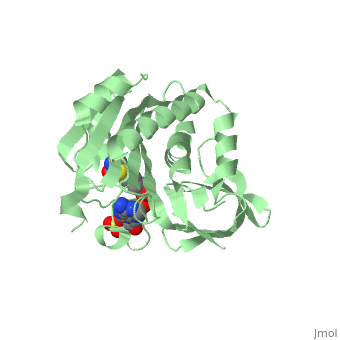Biotin Protein Ligase
From Proteopedia
(Difference between revisions)
| Line 1: | Line 1: | ||
{{STRUCTURE_1bia | PDB=1bia | SCENE=}} | {{STRUCTURE_1bia | PDB=1bia | SCENE=}} | ||
| - | + | <StructureSection load='4op0' size='450' side='right' scene= caption='Lymnaea acetylcholine-binding protein pentamer complex with acetylcholine (PDB code [[4op0]])'> | |
== Function == | == Function == | ||
| - | The attachment of [http://en.wikipedia.org/wiki/Biotin biotin] onto requiring proteins is catalysed by the ubiquitous enzyme '''biotin protein ligase''' (BPL), also known as the biotin inducible repressor, BirA, in E.coli and holocarboxylase synthase (HCS) in mammals. It was once believed a separate HCS existed for each of the carboxylases. However, with the availability of modern recombinant DNA technology and complete genome sequences, there is good evidence that only one biotin protein ligase is present in most bacteria, yeast and mammals. Arabidopsis thaliana and other plants species are a notable exception to this rule as they contain two HCS genes, one encoding a cytoplasmic enzyme and the other a chloroplast targeted enzyme. | + | The attachment of [http://en.wikipedia.org/wiki/Biotin biotin] onto requiring proteins is catalysed by the ubiquitous enzyme '''biotin protein ligase''' (BPL), also known as the biotin inducible repressor, BirA, in ''E.coli'' and holocarboxylase synthase (HCS) in mammals. It was once believed a separate HCS existed for each of the carboxylases. However, with the availability of modern recombinant DNA technology and complete genome sequences, there is good evidence that only one biotin protein ligase is present in most bacteria, yeast and mammals. ''Arabidopsis thaliana'' and other plants species are a notable exception to this rule as they contain two HCS genes, one encoding a cytoplasmic enzyme and the other a chloroplast targeted enzyme. |
Biotinylation is catalysed through a two-step reaction where biotin is first activated to biotinyl-5′-AMP in an ATP dependent manner. The biotin is then transferred onto the ε-amino group of a specific target lysine residue. The reaction mechanism is related to that of amino acyl-tRNA synthetases and lipoyl ligases where the reaction proceeds through the formation of an adenylated intermediate, suggesting a common ancestral relationship <ref>pmid 18442489</ref> . | Biotinylation is catalysed through a two-step reaction where biotin is first activated to biotinyl-5′-AMP in an ATP dependent manner. The biotin is then transferred onto the ε-amino group of a specific target lysine residue. The reaction mechanism is related to that of amino acyl-tRNA synthetases and lipoyl ligases where the reaction proceeds through the formation of an adenylated intermediate, suggesting a common ancestral relationship <ref>pmid 18442489</ref> . | ||
Revision as of 12:04, 11 November 2015
| |||||||||||
Proteopedia Page Contributors and Editors (what is this?)
Michal Harel, Nicole R Pendini, Alexander Berchansky, David Canner, Jaime Prilusky

